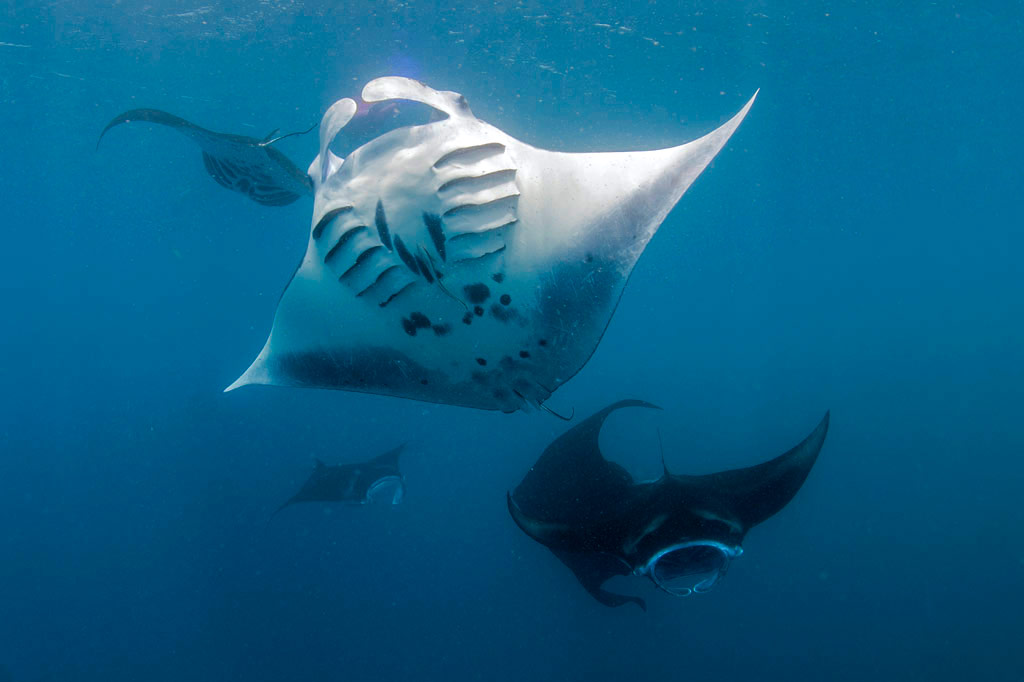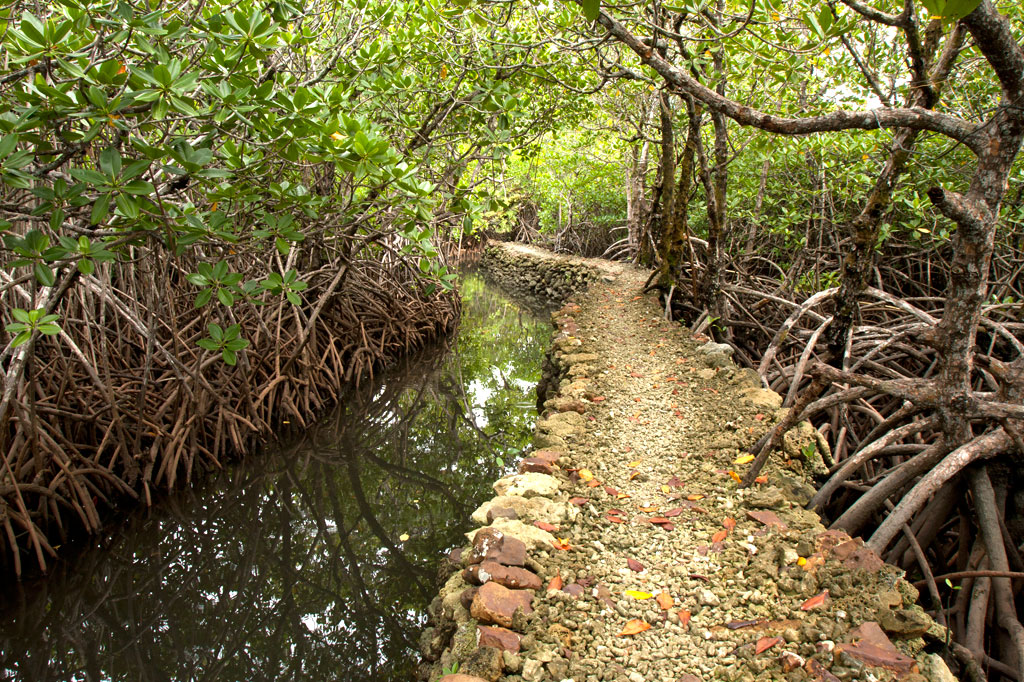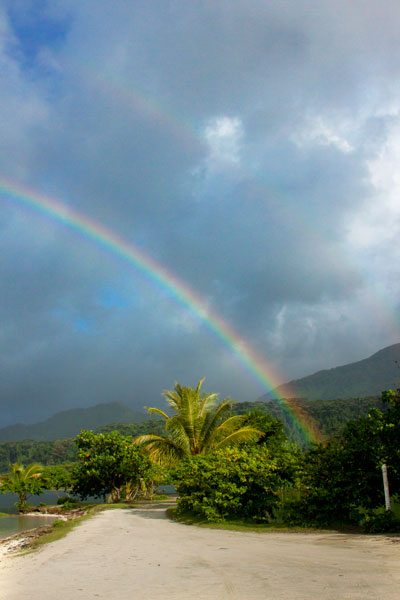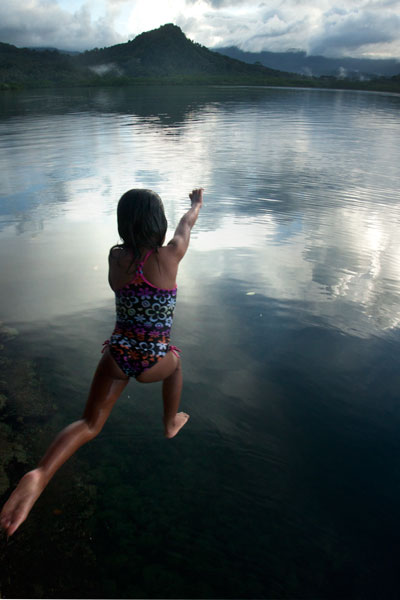“Manta Road”
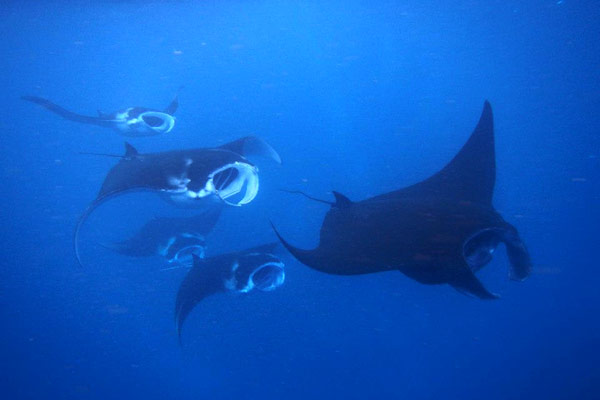
Manta Road is easily Pohnpei’s most famous dive spot due to its resident community of manta rays (including the all-black Black Morph variety) that cruise back and forth through the narrow channel as they filter-feed. The site is located between the fringing reef at the north end of Mwahnd Peidak (island) and a long strip of reef running northwest-southeast (2.75 km southeast of Kepidauen Mwahnd). The mantas mate between January and April, which is a good time of year to visit. Aim for the last hour of the out-going tide a few days on either side of the full moon. The channel has very strong currents — up to 7 knots — (which the mantas love), but which make diving and snorkeling tricky. You’ll want to avoid the spot on flood tides. The water can be crystal clear, but usually there are more mantas around when the visibility isn’t very good. Huge schools of fusiliers and jacks, as well as black-tip and white-tip reef sharks are common in the area. Small turtles are occasionally spotted. 3-24 meters. Best at about 16 meters. Advanced.
- Entering the MPA requires a permit. Visit our MPA page for details.
“Tubastrea Gardens”
This spot is located at a bridge about 17 meters down in the lagoon and about halfway between Parem and Mwahnd Peidak islands. The area is known for brightly-colored tubastrea (tube coral or sun coral) on the south side of the bridge. There are also a great many fish, though visibility is sometimes lacking. 15-20 meters. Best on an in-coming tide. Novice.
“Mwahnd Peidak”
This spot off the northeast side of Mwahnd Peidak’s fringing reef is notable for huge schools of parrotfish — a family of fish that is becoming relatively scarce in general. 3-18 meters. Best on an in-coming tide. Novice.
“Mwahnd Wall”
This drift-dive on the inner edge of the barrier reef south of Kepidauen Mwahnd is notable for the health and variety of corals and for reef sharks. The attractions go all the way down to 36 meters, which is where you’re most likely to find the sharks. Best on an in-coming tide. Advanced.
- Entering the MPA requires a permit. Visit our MPA page for details.
“Mwahnd Pass”
This drift-dive on the west side of Mwahnd Pass (Kepidauen Mwahnd) is known for its whip coral, gorgonian fans (below 30 meters), tree coral, and macro life. It’s also a good place for eagle rays, reef sharks, crinoids, feather stars, and napoleon wrasse. The wreck of a catamaran lies at the edge of the channel. 3-30 meters. Best at 12-15 meters on an in-coming tide. Advanced.
- Entering the MPA requires a permit. Visit our MPA page for details.
“Mwahnd Cove”
This drift-dive is on the southeast side of Mwahnd Pass (Kepidauen Mwahnd), beginning along the outer barrier reef wall and following the contour of the reef inside to a little coral bay dubbed “The Cove.” Attractions sometimes seen here include multitudes of mating eagle rays, moray eels, schools of barracuda (24 meters), whip coral, shrimp, and loads of white-tip reef sharks resting on the sandy bottom at about 30 meters. You might even be lucky enough to spot resident leopard sharks. 15-30 meters. Best at 24-30 meters on an in-coming tide. Advanced.
- Entering the MPA requires a permit. Visit our MPA page for details.
“Inner Mwahnd”
This spot is on the inside edge of the barrier reef south and east of Kepidauen Mwahnd (pass). The coral is abundant on the wall. Reef sharks, barracuda, and plenty of reef fish are also found in the area. 3-20 meters. Best on an in-coming tide. Intermediate.
- Entering the MPA requires a permit. Visit our MPA page for details.
“North Point”
Located at a sharp bend on the outside of the barrier reef, this wall dive is about sharks and large schools of pelagic fish. It’s quite a ways from any of the passes and the wind-exposed nature of the location means that the spot is only accessible during the summer. Down to 36 meters. Advanced.
“Lighthouse”
Sharks, pelagics, and more. This is a standard Pohnpei drift-dive that starts along the northern barrier reef wall and curves south into Kepidauen Pweitik (“Old Main Pass”). Best on an in-coming tide. Advanced.
“Lenger”
The areas north, south, and east of the Japanese seaplane ramp offer plenty for beginning divers. A variety of small reef fish, including gobies, angels, and parrots, octopi, sting rays, and lots of soft coral are found in the shallow coral grottoes. Visibility can range from terrible to very good. Best on a late in-coming tide. Novice.
“Parem”
This area on the fringing reef off the northwest end of Parem (island) offers more of the same kinds of attractions seen at Lenger. Visibility fluctuates greatly. Best on a late in-coming tide. Novice.
“Middle Pass” (Kepidauen Kiepw)
This spot is on the eastern corner of a narrow channel, called Kepidauen Kiepw, between Peinmen and Kepidauen Pweitik. The drift-dive starts on the outer edge of the reef wall and follows the reef south and east. This is a good place to see reef sharks. Best on an in-coming tide. Intermediate.
“Main Pass” (Peinmen)
This drift-dive begins along the northern edge of the barrier reef wall and follows the reef into Peinmen (Passage). Attractions include schools of black-tip and gray reef sharks (below 24 meters), occasional lemon sharks, schools of dog-tooth tuna, and sweetlips on the reef shelf at 24-30 meters. 5-30 meters. Best below 20 meters on an in-coming tide. Advanced.
“Sokehs Side Pass”
This little known spot in the narrow channel next to Peinmen is worth mentioning for the schools of large remoras that frequent the area. Best on an in-coming tide. Intermediate.
“Sandy Bottoms”
This blue hole on the inside edge of the barrier reef between “Main Pass” (Peinmen) and Palikir Pass (Kepidauen Palikir) is a great place for beginners to explore. Best on an in-coming tide. Novice.
“Palikir Bridge”
This is a deep dive that follows the reef bridge across the mouth of Kepidauen Palikir. It’s most famous for its schools of large pelagics, like tuna and wahoo, gorgonian fans, jacks, barracuda, humphead parrotfish, and huge schools of gray reef sharks. It’s also one of the places you might get a glimpse of Pohnpei’s little-seen tiger sharks. Currents can be strong. Best on an in-coming tide at 30-36 meters. Advanced.
“Palikir Wall”
This dive along the outer barrier reef wall west of Kepidauen Palikir is characterized by giant clams, triton’s trumpets, white-tip reef sharks, triggerfish, soft coral, and anemones. 9-37 meters. Best on an in-coming tide below 20 meters. Advanced.
ACKNOWLEDGMENTS
We’d like to extend a big kalahngan to Mike Viti, John Ranahan, and Karino Olpet for sharing their in-depth, first-hand knowledge about SCUBA diving on Pohnpei — without which this page could not have been created. Image Credits: Manta Road (Whitney McCurdie). All others licensed from www.shutterstock.com.


